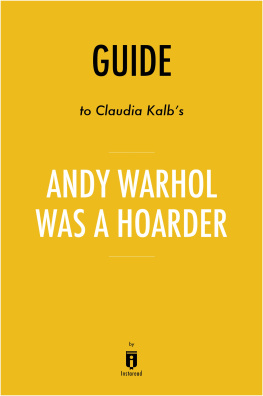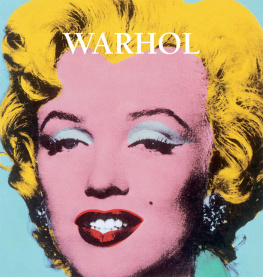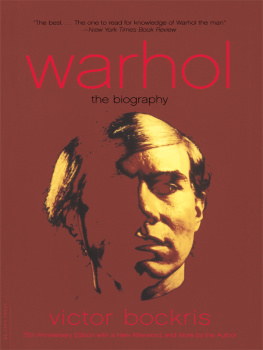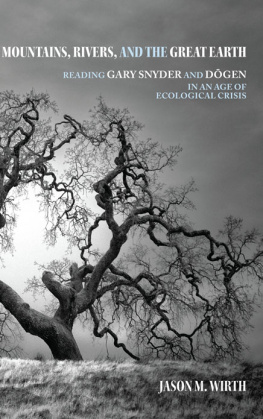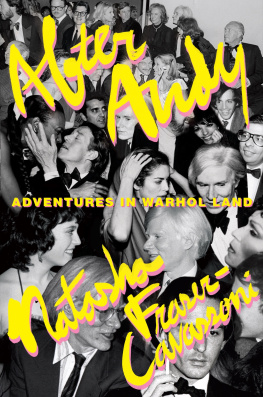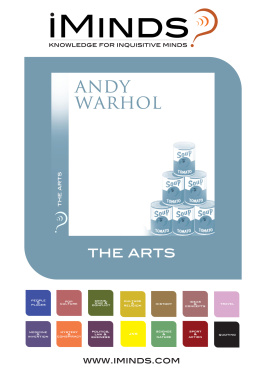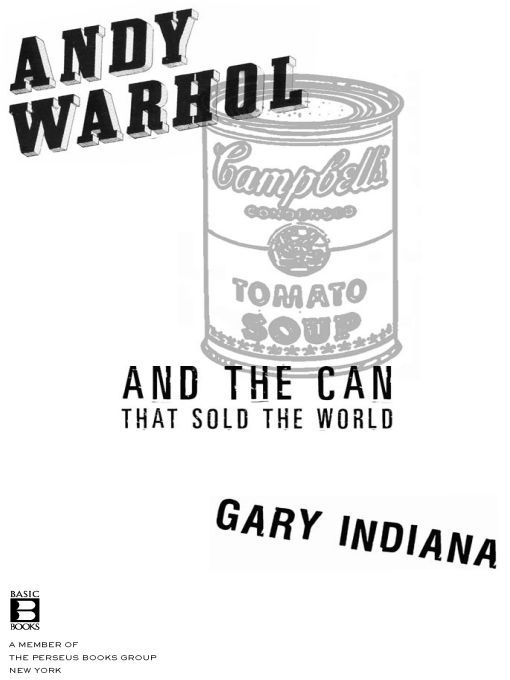Table of Contents
FOR
MARY WORONOV
AND
CHARLES RYDELL
ITS TOO HARD TO LOOK IN THE MIRROR. THERES NOTHING THERE.
ANDY WARHOL
interview with Jordan Crandall,
Splash, No. 6 (1986)
PREFACE
CLOSE TO A QUARTER-CENTURY AFTER HIS DEATH, Andy Warhol continues to evoke ambivalence and polarized appraisal, despite his works almost surreal financial appreciation.
Cultural conservatives disparage him and blame him for nearly everything appalling in American culture; at a different extreme, virtually everything he produced is lauded as prescient, masterful, and, especially, propheticand there are also those who think both judgments are true.
There is a museum devoted to his work in his home-town of Pittsburgh. A foundation that bears his name distributes millions for worthwhile artistic endeavors. A catalogue raisonn, years in the making and still incomplete, may dispel many confusions and myths concerning the circumstances in which Warhols vast oeuvre was generated. Yet the mythmaking porosity of Warhols enterprise will certainly retain its usefulness in the perpetual revision of the kind of history generated by rumor, gossip, and word of mouththe history that occurs before it becomes history in the sedimented, old-fashioned sense.
In the twentieth century, perhaps only Picasso left a comparably prodigious and variegated body of work, and therefore there will always be more to say about it. No one will ever get the final word on Andy Warhol. Like many people who came of age during the peak of the Warhol phenomenon, I considered him a brilliant provocateur, an artist of genius whose personality, as much as his art, exposed the vapid conformity, sexual repressiveness, and crass commercial values of American culture that prevailed during my childhood; like many, I read into Warhols ongoing enterprise a satirical contempt for the banality of that culture and its norms. That enterprise had, at first, a decidedly marginal character, appealed to a special kind of minority sensibility, and was valued precisely because of its countercultural insouciance. Later, however, as Warhols work achieved mainstream acceptance and the artist became synonymous with the culture of celebrity-for-its-own-sake and financial success as the measure of any artistic activitys value, I became far less admiring of Warhols achievement and much more critical of Warhols career as it played itself outwithout, I must add, ceasing to marvel at the audacity of his early work and his preternatural productivity or to appreciate the vast range of cultural practices and social changes, both baleful and appealing, that have been, to one degree or another, inspired by Warhols example.
If he had simply been a famous artist with a flashy personality, like Picasso, there would no doubt be firmer anchorage for assertions of intention, the parsing of works into clearly defined periods, and less skepticism about the value of the artists work overall.
In the case of Andy Warhol, the personality is one of implacable ambiguity, deliberate mystification, and a pose of complete detachment from his own work, a tyrant of passivity. Picasso began from a traditional fine art practice of painting that he revolutionized with Cubism and subsequent innovations. Warhol, who was trained in commercial art and first achieved eminence in that field, demolished the critical and perceptual boundaries separating fine and applied art, most memorably by exhibiting a series of Campbells Soup Can paintings in an art gallery.
Although hand-painted, the Soup Cans had the look of their industrially reproduced models. Warhol soon went further, applying the methods of mechanical reproduction to painting, including later versions of the Soup Cans; he extended this industrial model of production to sculpture and the whole gamut of customarily handmade works of art, glorifying the banal artifacts of American consumer culture and its icons of celebrity. The Soup Cans, at first widely dismissed as the ultimate cynical gimmick, were soon recognized as the first shots of a total revolution in American culture.
These pictures emitted no aura, no irreplaceable uniqueness, none of the qualities traditionally thought to emanate from works of art. What they conveyed was the enshrinement of a trademark commodity that the artist himself had had to swallow every day for lunch as a childa kind of condensed regurgitation of what America meant to Andy Warhol.
Yet whether the Soup Cans, and the staggering quantity of works that followed, signified contempt or reverence, love or loathing, a mixture of feelings or an absence of any feelings at all, could not be gleaned from the paintings themselves. And the artist had, by the time they were shown, perfected a laconic and distancing persona that confounded any definition and presented itself to the public as a glacial enigma.
This enigmatic quality, which made Warhol a celebrity, infused all his work with a kind of empty secret. It was there for others to interpret; the brilliantly terse aphorisms he coined about himself and his work, the interviews in which he claimed that other people did all his paintings for him, the exhibitionists he collected as a sort of protective gang around him, created a vast field of legend that steadily multiplied the value of everything he made.
Careers have been minted from inventories of innocently and not-so-innocently repeated, thousand-told anecdotes with dubious moorings in reality. The mind-numbing deluge of writings about Warhol includes factual slippages of every stripe, impossible-to-confirm stories, and, quite likely, facts that have been eclipsed by more interesting apocrypha.
We can each be one persons saint, anothers bastard, a thirds genius, and someone elses imbecile. Warhol was that rare individual who could be all these things, at the same time, to the same person. From the distance of an interested spectator, he certainly appeared to be that rarity to me.
PART ONE
Abjection and Epiphany
chapter one
THE BOY ON THE HILL
ONE
ANDY WARHOL CONTINUALLY REVISED AND MUDDIED his background. His contradictory self-inven tions were often freely embellished by those who heard them, though now, in posthumous finality, his densely veiled life may look slightly less veiled.
Authentic copies of his birth certificate have appeared in publications. His birthplace was just plain Pittsburghnot McKeesport, Pennsylvania, or Hawaii, or other places he sometimes claimed to have been born. Scholars can trace his movements from birth to his arrival in New York City, and, with considerably more difficulty, afterwards.
Born in 1928, Andy Warhola was the youngest of three brothers. Andys parents, Julia Zavacky and Ondrej Warhola, married in 1909 in Ruthenia, a Carpathian sliver of impoverished villages, epidemics, illiteracy, and hapless geography in the path of incessant territorial skirmishes between neighboring countries.
Ondrej, who had already spent three years working in the United States, returned to America three years after their wedding. A baby daughter was born after his departure and died before Ondrej earned enough money to bring his wife to the new country.
Julia never entirely recovered from this childs loss.


